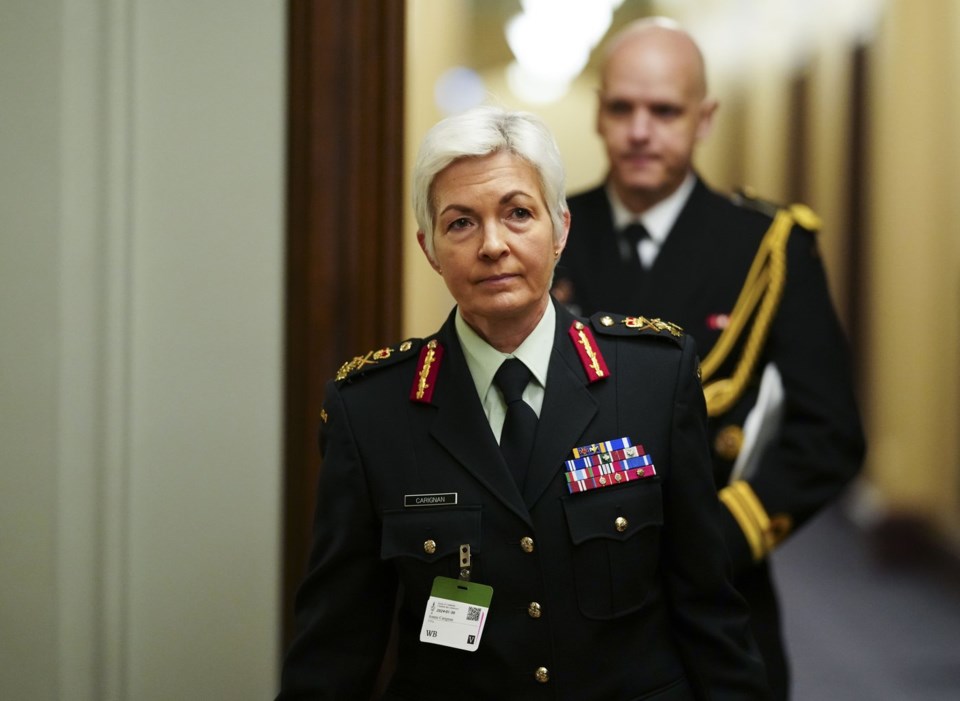OTTAWA — Canada's military will make history on Thursday when Jennie Carignan is promoted to the rank of general and takes over command as chief of the defence staff.
Her appointment to lead the Armed Forces comes at a time when the institution is under public scrutiny, as it tries to reverse what the defence minister calls a "death spiral" in recruitment while also reforming a toxic culture that gave way to the 2021 sexual misconduct crisis.
For the last three years, Carignan has led those reform efforts as the chief of professional conduct and culture. But the pressure on her is about to grow, observers say.
"As positive as it is to see the appointment of Canada’s first woman as (defence chief), it does appear in many ways like a 'glass cliff' situation, where a woman is appointed during a time of crisis and extensive challenges," said Maya Eichler, a professor of political and women's studies at Mount Saint Vincent University.
The so-called glass cliff is the notion that many women break through the "glass ceiling" to senior positions only when an organization is already in trouble — thereby making it harder for them to succeed.
Charlotte Duval-Lantoine, a fellow at the Canadian Global Affairs Institute who wrote a book about women's integration into the Canadian military, agreed that is a real concern.
"I think that one of the biggest challenges there will be, both for us but also for her, is managing expectations," she said.
Duval-Lantoine pointed out there were also high expectations for Anita Anand, who became the country's second female defence minister — and the first racialized woman to take the job — in late 2021.
At that time, the military had been embroiled in scandal for nearly a year, with several men forced out of leadership positions after СŔ¶ĘÓƵ publicly accused of sexual misconduct.
Anand was the minister in charge when former Supreme Court justice Louise Arbour submitted her external report on the military's culture, which called for a raft of changes.
The government accepted Arbour's recommendations, including creating the professional conduct and culture office that Carignan was put in charge of. Anand has previously said that she sought to keep the file at the centre of her desk at all times.
Wayne Eyre, who was named defence chief in 2021 after Adm. Art McDonald was accused of misconduct, said stabilizing the Armed Forces in the midst of that crisis was his top priority.
In late 2022, Eyre issued an order directing the military to make reconstitution its top priority. At the end of last year, he told troops the recruitment issues seemed to be stabilizing but would likely take years to solve.
Officials estimate that more than 16,000 jobs in the military's ranks are still unfilled.
Duval-Lantoine said personnel is likely to be the top issue for the military's next leader, and the slow recruitment process "needs to be fixed now."
"The Canadian Armed Forces don't need help attracting people ... You had 70,000 people last year who applied. Only 4,000 made it in," she said.
The federal government has also pledged to overhaul its notoriously slow defence procurement process as it pours money into building ships and shipbuilding capacity, buying fighter jets and replacing aging equipment.
Defence spending has risen by 57 per cent since 2014, with the 2024 budget at $29.9 billion.
Prime Minister Justin Trudeau's government is now targeting 2032 as the year Canada will meet its agreed-upon NATO spending pledge of two per cent of GDP — which by that time will amount to around $60 billion per year.
The defence chief's role is highly political, advocating for the Armed Forces with the civilian oversight in National Defence.
A consistent point of tension in the past several years has been what Eyre and other senior leaders call the increasing demand from politicians to respond to more frequent natural disasters in Canada while also boosting its presence on NATO's eastern front in Latvia and in the Indo-Pacific.
During last year's record wildfire season, more than 2,000 military members were deployed to fight fires across the country for 131 consecutive days.
This summer's fire season has been far less significant, but Armed Forces members were called in support an evacuation of Labrador City over the weekend — the first such deployment for 2024 — and officials are warning that the peak is yet to come.
Climate change is opening up new shipping lanes and possibly new vulnerabilities in the Arctic, as Defence Minister Bill Blair often says, and it is also leading to more frequent and more severe extreme weather events.
Blair and his colleagues in the Liberal cabinet have been clear they'll continue calling in the military for help when needed.
Eichler said clarity from Carignan would improve relations between the military and the government, and help Canadians better understand the challenges.
"What is really needed now more than ever is a broader national conversation about what Canadians expect of their military, what roles they want the military to focus on and what kind of institutional culture is best suited to fulfil those roles," she said.
This report by The Canadian Press was first published July 17, 2024.
Sarah Ritchie, The Canadian Press




